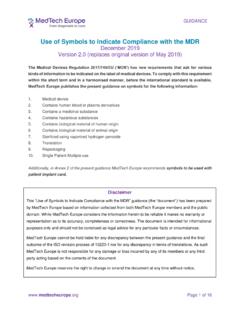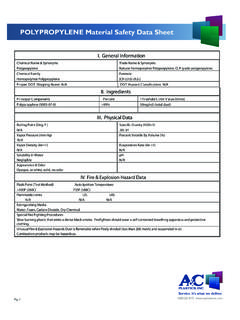Transcription of MedTech Europe guidance for assigning Basic UDI-DI
1 Page 1 of 18 guidance DOCUMENT MedTech Europe guidance for assigning Basic UDI-DI 2 June 2020 Aim of the document The MedTech Europe Basic UDI-DI guidance document aims to provide a framework for companies to help their Basic UDI-DI assignment. The document describes the legal and other connected rules - mainly arising from the EUDAMED1 database design - that are essential to understand before making decision on the Basic UDI-DI grouping. Introduction Within the EU, the manufacturer2 is legally responsible to assign both Basic UDI-DI and UDI-DI3 to their medical devices. The assignment of a Basic UDI-DI is not required by other jurisdictions. The manufacturer and the system or procedure pack producer are responsible for complying with UDI related requirements which includes the assignment of the UDI-DI and Basic UDI-DI and their registration in the EUDAMED database.
2 1 The European database on medical devices to be set up under Regulation (EU) 2017/745 and Regulation (EU) 2017/746 2 Note: mind the difference between the responsibility of the labeller in the US 3 The UDI stands for Unique Device Identification. The DI is the Device Identifier. Page 2 of 18 guidance DOCUMENT What is the Basic UDI-DI ? Basic UDI-DI legal requirements 1. As per Regulation (EU) 2017/745 (MDR) and Regulation (EU) 2017/746 (IVDR) Annex VI Part C definition: The Basic UDI-DI is the primary identifier of a device model. It is the DI assigned at the level of the device unit of use. It is the main key for records in the UDI database and is referenced in relevant certificates and EU declarations of conformity. Note: As per the related MDCG 2018-1 v3 guidance document, which provides more clarification to this definition, the Basic UDI-DI is not assigned at the level of unit of use.
3 2. As per MDCG 2018-1 v3 guidance :4 The Basic UDI-DI is the main access key in the database and relevant documentation ( certificates, declaration of conformity, technical documentation and summary of safety and clinical performance) to connect devices with same intended purpose, risk class and essential design and manufacturing characteristics. It is independent/separate from the packaging/labelling of the device and it does not appear on any trade item. Any Basic UDI-DI shall identify the devices (group) covered by that Basic UDI-DI in a unique manner. 3. As per the current EUDAMED database design (The current EUDAMED database design is not final yet. See Annex III of this document for more information.) The Basic UDI-DI is the access key for device-related information entered in the EUDAMED database.
4 The EUDAMED UDI device data dictionary defines all data elements that are associated with a Basic UDI-DI . Any change in the following data elements indicated with asterisk (*) requires the assignment and registration of a new Basic UDI-DI (Reference: April 2019 version of MDR UDI and device data sets to provide in EUDAMED and IVDR UDI and device data sets to provide in EUDAMED): 4 MDCG 2018-1 v3: This document has been endorsed by the Medical Device Coordination Group (MDCG) established by Article 103 of Regulation (EU) 2017/745. The MDCG is composed of representatives of all Member States and it is chaired by a representative of the European Commission. The document is not a European Commission document and it cannot be regarded as reflecting the official position of the European Commission.
5 Any views expressed in this document are not legally binding and only the Court of Justice of the European Union can give binding interpretations of Union law. Page 3 of 18 guidance DOCUMENT Note: SPPP stands for System / Procedure Pack Producer, Reference: Section in MDCG 2018-3 guidance on UDI for systems and procedure packs Page 4 of 18 guidance DOCUMENT Prior to making Basic UDI-DI grouping decisions, cross-functional collaboration is needed to consider the impact on: Documents where Basic UDI-DI is referenced: Technical Documentation (provided to Notified Body in conformity assessment application) EU Declaration of Conformity Product Certificate o EU Technical Documentation assessment certificate o EU type examination certificate o EU product verification certificate Certificate of Free Sale Summary of Safety and Clinical Performance (SSCP) for Medical Devices/ Summary of Safety and Performance (SSP) for IVDs Vigilance and Post-Market Surveillance Reports (auto-populated in EUDAMED if form is completed online).
6 O Manufacturer Incident Reporting form (MIR) o Periodic Summary Update Report (PSUR) o Field Safety Corrective Action Reporting form (FSCAR form) o Periodic Summary Report form (PSR) o Trend Reporting form Clinical investigation forms for post-market studies Others: Audits5 Instruction for Use6 5 The European Medical Device Nomenclature codes will be linked to NBOG codes more specifically to MDA / MDN - which is the basis for sampling by Notified Bodies as per Regulation (EU) 2017/2185 6 The MDR requires (IVDR does not require) to include a link to the SSCP in the IFU. One option as per the MDCG 2019-9 guidance on SSCP is to state the value of the Basic UDI-DI in the IFU. Alternatively, another metadata can be stated provided it can be used to unambiguously search and find the intended SSCP in EUDAMED.
7 See: MedTech Europe position paper on Provision of the Summary of Safety and Clinical Performance (SSCP) & link in the Instructions for Use (IFU) Feb 2020 Page 5 of 18 guidance DOCUMENT Basic UDI-DI Decision Tree (Please use the flow chart in conjunction with the explanations on the following page) This decision tree takes into account those considerations that are arising from the EUDAMED database design (indicated with blue) and those that are arising from the MDCG Basic UDI-DI guidance (indicated with orange). Page 6 of 18 guidance DOCUMENT Explanation for the Basic UDI-DI Decision Tree Question # Explanation 1 Does the device have the same Manufacturer SRN? Refer to the Manufacturer information on the product labelling who is legally responsible for the product and to whom the SRN is assigned.
8 2 Does the device have the same EU MDR/IVDR risk class and Basic UDI-DI data elements? a. For the applicable regulation MDR: to answer Yes , identify the risk class with applicable Basic UDI-DI data elements. The device must have the same following data elements: i. Implantable; ii. Active; iii. Reusable surgical instrument; iv. Measuring function; v. Presence of medicinal product substances; vi. Presence of medicinal product substance derived from human blood or human plasma; vii. Device intended to administer and/or remove medicinal product; viii. presence of human tissues or cells, or their derivates; ix. presence of animal tissues or cells, or their derivates; x. Special device types: software / orthopaedic / standard soft contact lenses / rigid gas permeable (RPG) & made-to-order soft contact lenses; b.
9 For the applicable regulation IVDR: to answer Yes , identify the risk class with applicable Basic UDI-DI data elements. The device must have the same following data elements: i. Intended for Near-patient-testing; ii. Intended for Self-testing; iii. Companion diagnostics; iv. Reagent; v. Instrument; vi. Professional testing; vii. Presence of human tissues or cells, or their derivates; viii. Presence of animal tissues or cells, or their derivates ix. Presence of substances / cells of microbial origin; x. Special device types: software Page 7 of 18 guidance DOCUMENT Note: Ensure all UDI-DIs under a Basic UDI-DI are the same risk class and have the same Basic UDI-DI data elements as listed above. 3 Does the device have the same intended purpose? Definition of intended purpose: means the use for which a device is intended according to the data supplied by the manufacturer on the label, in the instructions for use or in promotional or sales materials or statements and as specified by the manufacturer in the clinical evaluation (MDR Article ).
10 Note: The intended purpose does not necessarily align 1:1 with its indication. It typically represents the function that the device is used for (what does the device do to the patient or target organ, etc.). Devices may have the same intended purpose (same function) but could be used in a different patient population. 4 Will the device be included on the same product certificate7, same Declaration of Conformity, same SSCP/SSP, and/or same Technical Documentation as other devices assigned to the same Basic UDI-DI ? All devices covered by a given Basic UDI-DI should be on the same product certificate, SSCP/SSP, and/or Technical Documentation. Example*: * The example represents higher class devices and a best practice as understood based on the MDR and IVDR requirements by the industry experts who developed this external guidance document.












